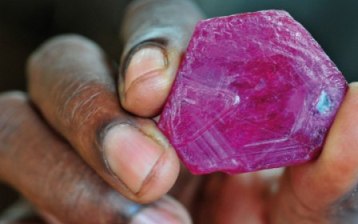The Montepuez Rubies And The Terrible Mixture
July 02, 12
By Luigi Costantini,
Head of Education in Italy, IGI – International Gemological Institute
Courtesy: L’Orafo Italiano
Dear jeweler, While running through – with the usual haste – a just as brief and hasty report on Mozambique rubies, my thoughts flew to you. To you and the face you will make after you have “set your sights” on a ruby entrusted to your care by a customer to have a setting made or to adjust the bezel-setting or claws.
|
|
I can just hear your colorful exclamations, which certainly won’t be cries of joy. You see, my friend, the ruby didn’t even have time to reach you from the Montepuez bush in Mozambique before others got their hands on them.
It began in 2009. At the time, the first stones crossing the Indian Ocean on their way eastwards were so uncommonly pure – that is to say without being profaned by any sort of treatment – it was like a dream.
Just a few months passed and the rubies that were coming out transformed from the workshops in Bangkok were vaguely reminiscent of the Mong Hsu (Myanmar) rubies.
The treatment for the Mong Hsu rubies has been used since the 1990s. Heat treatment at high temperatures combined with partial fracture (feathering) filling (with consequent healing) using flux. And we’re not talking about chocolate, but that terrible mixture of metallic oxides, also used in the production processes for synthetic stones made, exactly, from molten flux. Monstrous for you my friend when you see the molten flux seeping out of the cracks every time you whack a flame on them. This is the reason why my “thoughts take wing” to you, jeweler.
So before jumping into the fray to “take up where others have left off,” cast an eye on the stone. Better if it’s magnified a little (40X, 50X).
If you’re faced with partly filled cracks breaking the surface in continuous lines (meaning that the crack hadn’t been healed in those positions), prick up your ears. It doesn’t finish here. They’ve also injected glass infilling into some fractures, similar to the one used for treating rubies and diamonds with lead glass infilling.
It is true that the glass in our Mozambicans doesn’t have a lot of lead and bismuth, but it is still glass. Which means a lot of problems for you: glass melts and seeps out at the temperatures your blow-pipe is used to working at. It is also easy prey to attack from chemical reagents, including deterging solutions.
At this point don’t let yourself be taken in just by what you see: if you look inside those partly filled cracks, you may even find linear or ball-like devitrification inclusions or, even worse, what looks like fingerprints. And a thought anyhow flashes through my mind: but will this glass with little or no lead inside, still give me to those beautiful “flash effects,” such showy, striking and telltale signs of being treated?
What can we do? If I were you, not only would I start to equip myself a bit (any old microscope could be of help), I would also prepare a receipt book with a carbon copy disclaiming any responsibility, if it turns out to be a treated stone.
